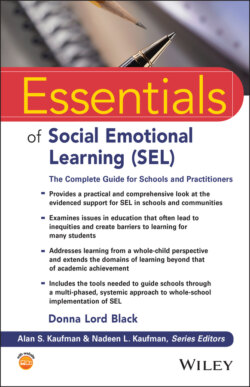Читать книгу Essentials of Social Emotional Learning (SEL) - Donna Lord Black - Страница 15
One DEFINING SOCIAL EMOTIONAL LEARNING (SEL) AND THE CRITICAL AREAS OF COMPETENCE
ОглавлениеThe realization that social and emotional skills matter as much as, if not more than, academic skills has captured the awareness of schools and communities around the world. Recognition of the critical role these skills play in educating children has swept across the globe and has created a wave of excitement, if not a worldwide phenomenon, that offers a promise of hope for the future of education. As SEL is embraced in schools throughout the world, educators are accepting that this is not simply another trend in education, but is the missing component in how students are educated and prepared for success, not only in school but at home, in the community, in the workforce, and in life. Unapologetically, schools are beginning to expand their focus beyond that of rigor and accountability for academic instruction to an educational program that focuses on the whole child, so that today’s students might be better prepared for life’s opportunities, responsibilities, and challenges.
While SEL is being embraced by more and more schools, implementation is not without its challenges. One of the biggest challenges is understanding that SEL is more than simply a program. Interest in SEL has risen so sharply that it has spurred the development and availability of a plethora of programs and curricula, along with books, articles, websites, blogs, and a host of other resources. While schools earnestly attempt to address the social and emotional development of their students, the rapid emergence of these pre‐scripted programs and curricula (often claiming to offer a complete package for SEL) can be enticing to schools. These programs can sometimes make implementation appear oversimplified and may lead to the use of already limited resources in an ineffective and inefficient manner. It is not uncommon, for example, for a school or district to adopt a particular program or strategy to address behavior and classroom management and believe this to be the entire solution for SEL. Implementing this single program not only adds to an already fragmented process, but also places the school at risk of making causal connections between the program and any outcomes, especially if those outcomes have not been successful. In such a case, the school might blame the lack of success on the program rather than considering other factors, such as fidelity of implementation or skill of staff implementing the program, as possible reasons for the lack of success.
Take, for example, Program XYZ. Let’s assume this hypothetical program uses an application for tablet computers (commonly referred to as “tablets”) to improve students’ social awareness skills by connecting them to one another through wireless technology. The school obtains a grant and purchases tablets for each student with the program’s application installed on each tablet. Teachers and students are trained in how to operate the program and all is well, until they experience repeated failures with maintaining wireless connections between the tablets. Without a stable connection, the program won’t operate. Thus, many of the teachers abandon its use. While the problems experienced with the program were related to technology issues (i.e., getting the tablets to communicate with one another) rather than the program itself, the teachers became disheartened and lost interest in the program. Six weeks later, the school principal discovers that a large number of teachers are no longer using the program, claiming it was ineffective. While there clearly was a positive correlation between the teachers’ skills in using technology and the program’s implementation (i.e., both decreased), this did not prove the program was ineffective. It merely showed that teachers lacked the skills needed for resolving the technology issues, and thus were unsuccessful with implementing the program. The program was abandoned before effectiveness could be evaluated, thus wasting valuable time and resources. In situations like this, schools run the risk of making causal connections between a program and its outcomes when, in fact, the relationship between the two may only have been correlational at best. Therefore, schools may be less likely to pursue other efforts to address these critical areas of need and may have difficulty recognizing that SEL is more than a program.
